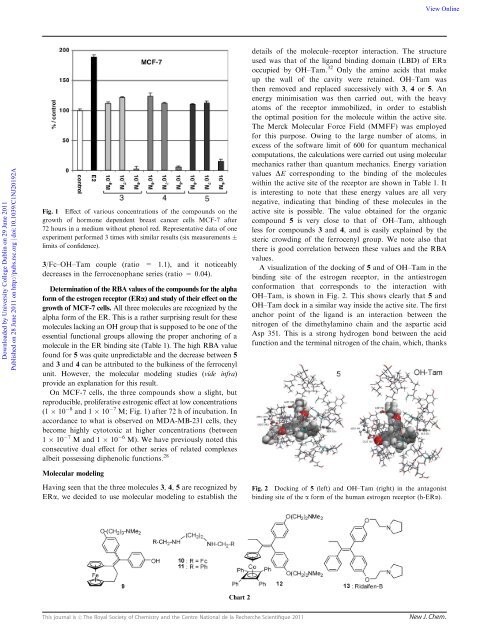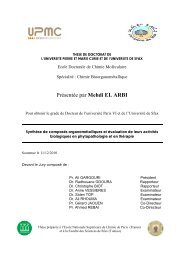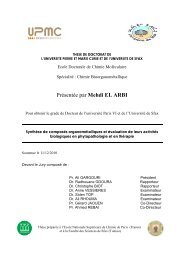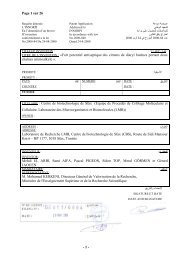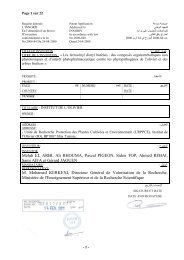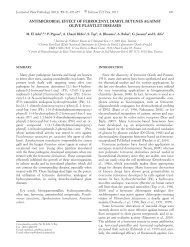A new series of ferrocifen derivatives, bearing two aminoalkyl chains
They possess the distinctive feature of combining a strong antiproliferative effect with intense antibacterial and antifungal activity
They possess the distinctive feature of combining a strong antiproliferative effect with intense antibacterial and antifungal activity
Create successful ePaper yourself
Turn your PDF publications into a flip-book with our unique Google optimized e-Paper software.
Downloaded by University College Dublin on 29 June 2011<br />
Published on 28 June 2011 on http://pubs.rsc.org | doi:10.1039/C1NJ20192A<br />
Fig. 1 Effect <strong>of</strong> various concentrations <strong>of</strong> the compounds on the<br />
growth <strong>of</strong> hormone dependent breast cancer cells MCF-7 after<br />
72 hours in a medium without phenol red. Representative data <strong>of</strong> one<br />
experiment performed 3 times with similar results (six measurements<br />
limits <strong>of</strong> confidence).<br />
3/Fc–OH–Tam couple (ratio = 1.1), and it noticeably<br />
decreases in the ferrocenophane <strong>series</strong> (ratio = 0.04).<br />
Determination <strong>of</strong> the RBA values <strong>of</strong> the compounds for the alpha<br />
form <strong>of</strong> the estrogen receptor (ERa) and study <strong>of</strong> their effect on the<br />
growth <strong>of</strong> MCF-7 cells. All three molecules are recognized by the<br />
alpha form <strong>of</strong> the ER. This is a rather surprising result for these<br />
molecules lacking an OH group that is supposed to be one <strong>of</strong> the<br />
essential functional groups allowing the proper anchoring <strong>of</strong> a<br />
molecule in the ER binding site (Table 1). The high RBA value<br />
found for 5 was quite unpredictable and the decrease between 5<br />
and 3 and 4 can be attributed to the bulkiness <strong>of</strong> the ferrocenyl<br />
unit. However, the molecular modeling studies (vide infra)<br />
provide an explanation for this result.<br />
On MCF-7 cells, the three compounds show a slight, but<br />
reproducible, proliferative estrogenic effect at low concentrations<br />
(1 10 8 and 1 10 7 M; Fig. 1) after 72 h <strong>of</strong> incubation. In<br />
accordance to what is observed on MDA-MB-231 cells, they<br />
become highly cytotoxic at higher concentrations (between<br />
1 10 7 M and 1 10 6 M). We have previously noted this<br />
consecutive dual effect for other <strong>series</strong> <strong>of</strong> related complexes<br />
albeit possessing diphenolic functions. 28<br />
Molecular modeling<br />
Having seen that the three molecules 3, 4, 5 are recognized by<br />
ERa, we decided to use molecular modeling to establish the<br />
Chart 2<br />
View Online<br />
details <strong>of</strong> the molecule–receptor interaction. The structure<br />
used was that <strong>of</strong> the ligand binding domain (LBD) <strong>of</strong> ERa<br />
occupied by OH–Tam. 32 Only the amino acids that make<br />
up the wall <strong>of</strong> the cavity were retained. OH–Tam was<br />
then removed and replaced successively with 3, 4 or 5. An<br />
energy minimisation was then carried out, with the heavy<br />
atoms <strong>of</strong> the receptor immobilized, in order to establish<br />
the optimal position for the molecule within the active site.<br />
The Merck Molecular Force Field (MMFF) was employed<br />
for this purpose. Owing to the large number <strong>of</strong> atoms, in<br />
excess <strong>of</strong> the s<strong>of</strong>tware limit <strong>of</strong> 600 for quantum mechanical<br />
computations, the calculations were carried out using molecular<br />
mechanics rather than quantum mechanics. Energy variation<br />
values DE corresponding to the binding <strong>of</strong> the molecules<br />
within the active site <strong>of</strong> the receptor are shown in Table 1. It<br />
is interesting to note that these energy values are all very<br />
negative, indicating that binding <strong>of</strong> these molecules in the<br />
active site is possible. The value obtained for the organic<br />
compound 5 is very close to that <strong>of</strong> OH–Tam, although<br />
less for compounds 3 and 4, and is easily explained by the<br />
steric crowding <strong>of</strong> the ferrocenyl group. We note also that<br />
there is good correlation between these values and the RBA<br />
values.<br />
A visualization <strong>of</strong> the docking <strong>of</strong> 5 and <strong>of</strong> OH–Tam in the<br />
binding site <strong>of</strong> the estrogen receptor, in the antiestrogen<br />
conformation that corresponds to the interaction with<br />
OH–Tam, is shown in Fig. 2. This shows clearly that 5 and<br />
OH–Tam dock in a similar way inside the active site. The first<br />
anchor point <strong>of</strong> the ligand is an interaction between the<br />
nitrogen <strong>of</strong> the dimethylamino chain and the aspartic acid<br />
Asp 351. This is a strong hydrogen bond between the acid<br />
function and the terminal nitrogen <strong>of</strong> the chain, which, thanks<br />
Fig. 2 Docking <strong>of</strong> 5 (left) and OH–Tam (right) in the antagonist<br />
binding site <strong>of</strong> the a form <strong>of</strong> the human estrogen receptor (h-ERa).<br />
This journal is c The Royal Society <strong>of</strong> Chemistry and the Centre National de la Recherche Scientifique 2011 New J. Chem.


